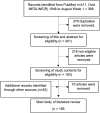Toll-Like Receptor Signalling Pathways and the Pathogenesis of Retinal Diseases
- PMID: 38983565
- PMCID: PMC11182157
- DOI: 10.3389/fopht.2022.850394
Toll-Like Receptor Signalling Pathways and the Pathogenesis of Retinal Diseases
Abstract
There is growing evidence that the pathogenesis of retinal diseases such as diabetic retinopathy (DR) and age-related macular degeneration (AMD) have a significant chronic inflammatory component. A vital part of the inflammatory cascade is through the activation of pattern recognition receptors (PRR) such as toll-like receptors (TLR). Here, we reviewed the past and current literature to ascertain the cumulative knowledge regarding the effect of TLRs on the development and progression of retinal diseases. There is burgeoning research demonstrating the relationship between TLRs and risk of developing retinal diseases, utilising a range of relevant disease models and a few large clinical investigations. The literature confirms that TLRs are involved in the development and progression of retinal diseases such as DR, AMD, and ischaemic retinopathy. Genetic polymorphisms in TLRs appear to contribute to the risk of developing AMD and DR. However, there are some inconsistencies in the published reports which require further elucidation. The evidence regarding TLR associations in retinal dystrophies including retinitis pigmentosa is limited. Based on the current evidence relating to the role of TLRs, combining anti-VEGF therapies with TLR inhibition may provide a longer-lasting treatment in some retinal vascular diseases.
Keywords: age-related macular degeneration; diabetic retinopathy; genetic polymorphisms; inflammation; ischaemic retinopathy; retinal diseases; retinal dystrophies; toll-like receptors.
Copyright © 2022 Titi-Lartey, Mohammed and Amoaku.
Conflict of interest statement
The authors declare that the research was conducted in the absence of any commercial or financial relationships that could be construed as a potential conflict of interest.
Figures





Similar articles
-
The role of Toll-like receptors in retinal ischemic diseases.Int J Ophthalmol. 2016 Sep 18;9(9):1343-51. doi: 10.18240/ijo.2016.09.19. eCollection 2016. Int J Ophthalmol. 2016. PMID: 27672603 Free PMC article. Review.
-
The contribution of pattern recognition receptor signalling in the development of age related macular degeneration: the role of toll-like-receptors and the NLRP3-inflammasome.J Neuroinflammation. 2024 Mar 5;21(1):64. doi: 10.1186/s12974-024-03055-1. J Neuroinflammation. 2024. PMID: 38443987 Free PMC article. Review.
-
Retinal Pigment Epithelium Expressed Toll-like Receptors and Their Potential Role in Age-Related Macular Degeneration.Int J Mol Sci. 2021 Aug 4;22(16):8387. doi: 10.3390/ijms22168387. Int J Mol Sci. 2021. PMID: 34445096 Free PMC article. Review.
-
Toll-Like Receptors and Age-Related Macular Degeneration.Adv Exp Med Biol. 2018;1074:19-28. doi: 10.1007/978-3-319-75402-4_3. Adv Exp Med Biol. 2018. PMID: 29721923 Review.
-
Expression of Toll-like receptors in human retinal and choroidal vascular endothelial cells.Exp Eye Res. 2015 Sep;138:114-23. doi: 10.1016/j.exer.2015.06.012. Epub 2015 Jun 17. Exp Eye Res. 2015. PMID: 26091789
Cited by
-
Effects of Acute Cold Stress after Intermittent Cold Stimulation on Immune-Related Molecules, Intestinal Barrier Genes, and Heat Shock Proteins in Broiler Ileum.Animals (Basel). 2022 Nov 23;12(23):3260. doi: 10.3390/ani12233260. Animals (Basel). 2022. PMID: 36496781 Free PMC article.
-
Construction of an Exudative Age-Related Macular Degeneration Diagnostic and Therapeutic Molecular Network Using Multi-Layer Network Analysis, a Fuzzy Logic Model, and Deep Learning Techniques: Are Retinal and Brain Neurodegenerative Disorders Related?Pharmaceuticals (Basel). 2023 Nov 2;16(11):1555. doi: 10.3390/ph16111555. Pharmaceuticals (Basel). 2023. PMID: 38004422 Free PMC article.
-
TLR2 and TLR4 Are Expressed in Epiretinal Membranes: Possible Links with Vitreous Levels of Complement Fragments and DAMP-Related Proteins.Int J Mol Sci. 2024 Jul 15;25(14):7732. doi: 10.3390/ijms25147732. Int J Mol Sci. 2024. PMID: 39062973 Free PMC article.
-
TLR4 deficiency does not alter glaucomatous progression in a mouse model of chronic glaucoma.bioRxiv [Preprint]. 2024 Jun 8:2024.06.07.597951. doi: 10.1101/2024.06.07.597951. bioRxiv. 2024. PMID: 38895321 Free PMC article. Preprint.
-
Molecular and Cellular Mechanisms Involved in the Pathophysiology of Retinal Vascular Disease-Interplay Between Inflammation and Oxidative Stress.Int J Mol Sci. 2024 Nov 4;25(21):11850. doi: 10.3390/ijms252111850. Int J Mol Sci. 2024. PMID: 39519401 Free PMC article. Review.
References
-
- Hageman GS, Luthert PJ, Victor Chong NH, Johnson LV, Anderson DH, Mullins RF. An Integrated Hypothesis That Considers Drusen as Biomarkers of Immune-Mediated Processes at the RPE-Bruch’s Membrane Interface in Aging and Age-Related Macular Degeneration. Prog Retin Eye Res (2001) 20(6):705–32. doi: 10.1016/s1350-9462(01)00010-6 - DOI - PubMed
Publication types
LinkOut - more resources
Full Text Sources
Other Literature Sources
Miscellaneous

